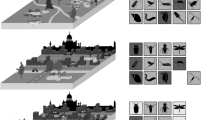Abstract
We assessed the benefit of 11 gravel pits for the settlement of waterbird communities in an urbanized area lacking natural wetlands. Gravel pits captured 57% of the regional species pool of aquatic birds. We identified 39 species, among which five were regionally rare. We used the Self-Organizing Map algorithm to calculate the probabilities of presence of species, and to bring out habitat conditions that predict assemblage patterns. The age of the pits did not correlate with assemblage composition and species richness. There was a positive influence of macrophyte cover on waterbird species richness. Larger pits did not support more species, but species richness increased with connectivity. As alternative wetland habitats, gravel pits are attractive to waterbirds, when they act as stepping stones that ensure connectivity between larger natural and/or artificial wetlands separated in space.





Similar content being viewed by others
References
Barnaud, G. & F. Le Bloch, 1998. Entre terre et eau, agir pour les zones humides. Dossier d’Information du Ministère de l’Aménagement du Territoire et de l’Environnement (France).
Blindow, I., A. Hargeby & G. Andersson, 2000. Long-term waterfowl fluctuations in relation to alternative states in two shallow lakes. In Comín, F. A., J. A. Herrera & J. Ramírez (eds), Limnology and Aquatic Birds. Monitoring, Modelling and Management. Proceedings of the 2nd International Symposium on Limnology and Aquatic Birds. Universidad Autónoma de Yucatán, Mérida: 165–175.
Bournaud, M., J. P. Ledant, J. P. Broyer & M. Richoux, 1982. L’espace étang dans ses rapports avec l’avifaune en période de nidification. Bulletin d’Ecologie 13: 125–144.
Céréghino, R., F. Santoul, A. Compin & S. Mastrorillo, 2005. Using self-organizing maps to investigate spatial patterns of non-native species. Biological Conservation 125: 459–465.
Céréghino, R., A. Ruggiero, P. Marty & S. Angélibert, 2008. Biodiversity and distribution patterns of freshwater invertebrates in farm ponds of a southwestern French agricultural landscape. Hydrobiologia 597: 43–51.
Colwell, R. K., C. X. Mao & J. Chang, 2004. Interpolating, extrapolating, and compared incidence-based species accumulation curves. Ecology 85: 2717–2727.
Cucherousset, J., F. Santoul, J. Figuerola & R. Céréghino, 2008. How do biodiversity patterns of river animals emerge from the distributions of common and rare species? Biological Conservation 141: 2984–2992.
Declerck, S., T. De Bie, D. Ercken, H. Hampel, S. Schrijvers, J. Van Wichelen, V. Gillard, R. Mandiki, B. Losson, D. Bauwens, S. Keijers, W. Vyverman, B. Goddeeris, L. De Meester, L. Brendonck & K. Martens, 2006. Ecological characteristics of small farmland ponds: associations with land use practices at multiple spatial scales. Biological Conservation 131: 523–532.
Frochot, B. & V. Godreau, 1995. Intérêt écologique des carrières, terrils et mines. Natures Sciences Sociétés 3 (special issue): 66–76.
Frochot, B., V. Godreau & J. Roché, 2008. L’expansion récente des oiseaux d’eau. Alauda 76: 279–286.
Fuller, R. J. & M. Ausden, 2008. Birds and habitat change in Britain. Part I: a review of losses and gains in the twentieth century. British Birds 101: 644–675.
Gillier, J. M., R. Mahéo & F. Gabillard, 2000. Les comptages d’oiseaux d’eau hivernant en France: actualisation des connaissances, effectifs moyens, critères numériques d’importance internationale et nationale. Alauda 68: 45–54.
Hoyer, F., 1994. Rôle des gravières et des lacs colinéaires. Le journal du chasseur 39: 6–15.
Hull, A., 1997. The pond life project: a model for conservation and sustainability. In Boothby, J. (ed.), British Pond Landscape, Proceedings from the UK Conference of the Pond Life Project. Pond Life Project, Liverpool: 101–109.
Knapton, R. W. & S. A. Petrie, 1999. Changes in distribution and abundance of submerged macrophytes in the inner bay at Long Poing, Lake Erie: implications for foraging waterfowl. Journal of Great Lakes Research 25: 783–798.
Leroy, C., M. Guéroult, N. S. Wahyuni, J. Escoute, R. Céréghino, S. Sabatier & D. Auclair, 2009. Morphogenetic trends in morphological, optical, biochemical features of phyllodes in Acacia mangium Willd (Mimosaceae). Trees – Structure and Function 23: 37–49.
Lodge, D. M., G. Cronin, E. Van Donk & A. J. Froelich, 1998. Impact of herbivory on plant standing crop: comparisons among biomes, between vascular and among freshwater herbivory taxa. In Jeppensen, E., M. Sondergaard & K. Christoffersen (eds), The structuring role of submerged macrophytes in lakes. Springer-Verlag, New York: 149–174.
Maurel, C., C. Arthur, G. Bechard, J. F. Bousquet, M. Fily, V. Heaulme, J. Joachim, E. Menoni & H. Redon, 2004. Liste de collemboles déterminants. In Durand C., L. Pontcharraud & A. Bertrand (eds), Modernisation de l’inventaire des Zones Naturelles d’Intérêt Ecologique, Faunistique et Floristique (Znieff) en Midi-Pyrénées. Listes préliminaires d’espèces et cortèges de faune déterminants. Conservatoire Régional des Espaces Naturels de Midi-Pyrénées, DIREN Midi-Pyrénées, European Union: 17–29.
Myers, N., R. A. Mittermeier, C. G. Mittermeier, G. A. B. da Fonseca & J. Kent, 2000. Biodiversity hotspots for conservation priorities. Nature 403: 853–858.
Odling-Smee, L., 2005. Dollars and sense. Nature 437: 614–616.
Oertli, B., D. Auderset Joye, E. Castella, R. Juge & J. B. Lachavanne, 2000. Diversité biologique et typologie écologique des étangs et petits lacs de Suisse. Technical Report, LEBA, Université de Genève: 434 pp.
Park, Y. S., R. Céréghino, A. Compin & S. Lek, 2003. Applications of artificial neural networks for patterning and predicting aquatic insect species richness in running waters. Ecological Modelling 160: 265–280.
Rey-Benayas, J. M., S. M. Scheiner, M. Garcia Sanchez-Colomer & C. Levassor, 1999. Commonness and rarity: theory and application of a new model to Mediterranean montane grasslands. Conservation Ecology 3: 5.
Author information
Authors and Affiliations
Corresponding author
Additional information
Guest editors: B. Oertli, R. Cereghino, A. Hull & R. Miracle
Pond Conservation: From Science to Practice. 3rd Conference of the European Pond Conservation Network, Valencia, Spain, 14–16 May 2008
Rights and permissions
About this article
Cite this article
Santoul, F., Gaujard, A., Angélibert, S. et al. Gravel pits support waterbird diversity in an urban landscape. Hydrobiologia 634, 107–114 (2009). https://doi.org/10.1007/s10750-009-9886-6
Published:
Issue Date:
DOI: https://doi.org/10.1007/s10750-009-9886-6




